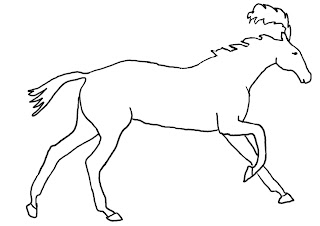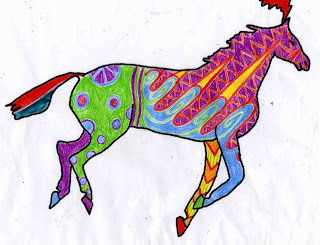Wednesday, July 1, 2009
Rockmount Workshops
Monday, June 29, 2009
Working with you
Tuesday, June 23, 2009
Now onto Making the Animation!!

Set for High Wire Animation.
We had a system in creating other animation sufficiently by having 2 of us in the studio taking the stills whilst 2 of us in the Mac suite putting the previous stills together using Final Cut Pro. I would say we stuck to our strengths but we found it was best to occasionally swop roles for a bit to get a fresh look on things.
The whole process was pretty straight forward, just very time consuming considering the number of frames we were making. We constantly had to make sure the camera was aligned properly (this allows us to avoid cropping the frames when editing) when we put it back on the tripod after running the memory card back up to the Mac suite.
I was new to using Final Cut Pro so it was daunting at first but Clara Garcia Fraile (our artist in residence) was there to help and she gave us a booklet that explained each step. Using this programme we were able to increase the scale, level the angles, change the sequence, adjust the brightness and the timing of the original frames. IMPORTANT RULE: SAVE WORK REGULARY!!!

Using Final Cut Pro.
Once all the editing was complete and we were packed up in the studio all that was left to do was burn it onto a disc. Typically, this was the most frustrating thing of all – it took so long due to its size.
Clara actually said this was the software many TV/Movie makers would use, so who knows: This week Bloomsbury, next week Hollywood!!
First week on the project
To start with we had to research into community art, we looked at animation artists like Blu, director Jeff Chiba Stearns- (yellow sticky notes), Scott Coello- (she farted and created the world).
We also had a visiting animation artists named Clara, she showed us her work , which was rely interesting it was (interactive animation ) which got people to respond to hew work be doing something physical.
She also did a work shop with us , where we made our own trial stop frame animation’s .
She was also to come in later on in the projects to teach us how to use final cut pro to make our animation’s in .
We had to do a lot planning for the 3 days, making
trials, and lesson plans for designs of the horses and textures and what we were going to do in our workshops each day.
I had the a tedious task of drawing and photo copying 25 different horses for the work shops
At the end of the week we had to make sure we had all our materials together which was a lot!


Monday, June 22, 2009
The Week After School: Making the Animation
After everything was scanned and organised (which was a day's work), we went to the Mac Room (this was the next day). Clara, an experienced animator and tutor for this project, was our guide in teaching us how to use Final Cut Pro, a movie editing program which we were using to create our animations in. To create our animation, we have to import a whole selection of images into the library, and select the ones we need and for how many frames they will appear on screen. Final Cut runs in 24 frames per second, so for example, making an image change every 2 frames (often called "animating in twos") would make it 12 frames per second. We chose to animate in 3s, so 8 frames per second.

We were told that a required element of the animation is to have a black background. Rather than go over every frame of the horse animation in photoshop and making the background black, we were told of a quick fix by Clara; to simply invert all the pictures with a filter built into Final Cut Pro. While first skeptical about how this would look, as it would invert all of the colours on the horse and not just the black and whites, it ended up giving our horse a much more magical feel, making some parts like the feather appear to be glowing due to the inverting of the shadows.
After we had added all the frames of the animation, making the horse stand, walk, canter, gallop, and then slow down to a halt, we cleaned up a lot of frames (getting rid of the mess for the really messy frames that were made by monoprints). Once this was done, the only thing left was to add the sound effects to the horse. We went over to production to collect a variety of sound effects for the horse, and edited them in, trying to loop it best we can. After we did this, everything was done with the animation, and the only thing remaining is to have it burned to disc.

However, that wasn't the end as it turned out. Production thought the sound quality could be better, so they decided to handle it themselves. We were then handed music that we imported and added to the animation. Later, we were shown the horse animation projected, and were shown some problems with it, such as the slight change in scale and some of the unseeable colours from some of the monoprinted horses. We were then instructed to make all the horse frames the same size as a certain frame that they picked out, and to colour all of the unseeable frames. After hours of rotating, scaling, and colouring images in photoshop, we were officially done.

Saturday, June 13, 2009
Teaching week
The next day, we were doing paper maché. The group, being a fiery group, got really involved and enthusiastic but also got really messy. I did say in the demo to take off the excess glue over the glue pots but they seemed to forget this. This meant that all the people in our group were cleaning up accidently spilt glue, refilling glue pots and salvaging peoples work from being water logged with glue and no one was directing the class because we all had our hands full. Towards the end of the lesson, the group pulled together more with help from Toby and we got them to finish and go to break on time but there was a lot of tidying up to do that the students did not do properly or didn’t do because of the lack of time. Toby (our tutor) had to give us constructive criticism and extra help because this lesson was a bit to noisy and chaotic. She also gave us Issy to work with increasing our group from 3 members to 4 which is the amount that the other groups had. After their break we did textile sheets, Rebecca was in charge of giving demos and Issy seemed to gain control of the class and made them quieter but this could also be because we were not doing a messy exiting lesson, it was much more pleasant then the first half of the lesson.
On the final day of teaching we had to disappoint our group because we said that we would be using the computers and we were known as the ICT group but unfortunately they did not have Photoshop. Instead the kids made a design of what they wanted to paint the paper mache horses like, and then Jack gave a demo on mixing paint to get different colours because lots of them did not know how to do this. Then finally they painted their horses.
The kids were sad to see us go, i was happy with the work the students produced. Also for some reason all the students really liked cleaning up.

Thursday, June 11, 2009
"If u can give a child only one gift, let it be ENTHUSIASM!!"

I think i can speak on behalf of all of my group when i say, entering Rockmount primary school - we were equally petrified. In a neat, nervous line behind Diane, we followed obediently to our classroom of residence for the next three days. As we clutched on to our art and craft materials we stepped into the hall; lining the walls were stacks of tiny chairs, reminding us that the workshops were for children - nothing scary about that right?
As we began re-arranging the tables, mats, chairs and art materials; the room started looking like our own space - making us feel slightly more at home. A faint rumble sounded from outside the hall as the anticipation rose: the children started were arriving. The door creaked open as the four of us stood in a line at the front of the room, ready to welcome our new students. A sweet smiling face peaked round the door, "Can we come in?" Delight spread across our faces as i nodded and welcomed them in.
Our first activity (papier mache balloons), went down a treat with the children - giving them the permanent title of "The Messy group". In our group discussion on the mat area, the children threw iniviative and unique ideas associated with the circus - little did we know that when we started the discussion, we would soon be accompanied by a steal pan band in the room next door.